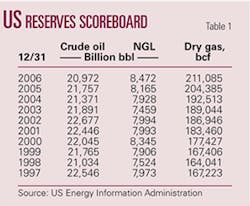US proved reserves of gas were up 3.3% in 2006 compared with 2005, natural gas liquids reserves were up 3.8%, and crude oil reserves fell 3.6%, the Energy Information Administration reported.
Reserves at Dec. 31, 2006, totaled 20.97 billion bbl of crude oil, 211 tcf of gas, and 8.47 billion bbl of NGL.
Operators replaced 136% of the dry gas produced, 138% of the NGL produced, and 52% of the oil produced in 2006.
Gas reserves
EIA attributed the gas reserves increase, to the highest level since 1976, mainly to a 9% increase in dry gas proved reserves in Texas from rapid development of Barnett shale reservoirs in Newark East field.
US dry gas reserves stood at 164 tcf at the end of 1998 and have increased in each of the 8 years since.
Operators discovered 23.3 tcf of gas in all types of exploratory wells in 2006, 35% more than the prior 10-year average. Of that, 21.8 tcf came from field extensions, 1.2 tcf came from new reservoirs in existing fields, and only 409 bcf came from new field discoveries.
Coalbed gas reserves fell 1% to 19.6 tcf, and coalbed gas production climbed 2% to 1.76 tcf. Gulf of Mexico deepwater federal reserves dropped 14% to 14.9 tcf, and deepwater production fell 6% to 2.8 tcf.
Alaska and Utah were second and third for dry gas proved reserves additions in 2006.
Dry gas production increased to 18.545 tcf in 2006 on gains in the Barnett shale, Louisiana, and Colorado, Wyoming, Utah, and Montana. The Gulf of Mexico showed a 6% drop.
Deepwater gas represented 39.6% of US dry gas production, up from 36.1%, and CBM made up 9%.
Gas prices at the wellhead fell 12% to $6.42/Mcf, and gas well completions were up 17% in 2006.
Oil reserves
The Gulf of Mexico and Alaska oil reserves fell 10% and 7%, respectively, fueling the overall US oil reserves drop, EIA said.
Utah had the largest increase. It added 78 million bbl, most of which came from upward revisions and acquisitions, to end the year at 334 million bbl. Colorado and New Mexico had smaller oil reserves additions.
Montana’s oil reserves fell 2% to 419 million bbl, but for the second year in a row the state had the largest annual oil production increase6 million bblto 36 million bbl for the year, with continued Bakken shale development in difficult-to-produce Elm Coulee field.
Of the oil reserves added in 2006, 504 million bbl came from extensions, 43 million bbl from new reservoirs in existing fields, and 30 million bbl from new field discoveries. Seventy percent of the new field discoveries were in the gulf.
The average first-purchase price for crude oil was up 19% to $59.69/bbl, and oil well completions were 28% higher than in 2005.

